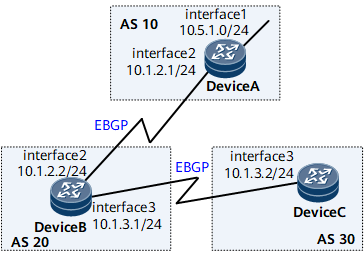Example for Configuring the BGP Community Attribute
By setting the community attribute, you can flexibly control BGP route selection.
Networking Requirements
Enterprises A, B, and C are in three ASs, the network of enterprise B is connected to the networks of the other two enterprises. Enterprise A and C are rivals, and enterprise A requires that the routes it sends to enterprise B be transmitted only within enterprise B. In this situation, you can configure the community attribute on the router in enterprise A that sends routes to enterprise B.
In Figure 1, EBGP connections are established between Device B and Device A, and between Device B and Device C. It is required that the routes advertised from AS 10 to AS 20 are not advertised to other ASs by AS 20. In this situation, configure the community attribute No_Export on Device A.
Configuration Roadmap
The configuration roadmap is as follows:
Establish EBGP connections between Device A andDevice B, and between Device B and Device C.
Configure a routing policy on Device A to advertise the community attribute No_Export.
Data Preparation
To complete the configuration, you need the following data:
Router ID and AS number of Device A
Router ID and AS number of Device B
Router ID and AS number of Device C
Procedure
- Configure an IP address for each interface. For configuration details, see Configuration Files in this section.
- Configure EBGP connections.
# Configure Device A.
[~DeviceA] bgp 10 [*DeviceA-bgp] router-id 1.1.1.1 [*DeviceA-bgp] peer 10.1.2.2 as-number 20 [*DeviceA-bgp] ipv4-family unicast [*DeviceA-bgp-af-ipv4] network 10.5.1.0 255.255.255.0 [*DeviceA-bgp-af-ipv4] commit [~DeviceA-bgp-af-ipv4] quit
# Configure Device B.
[~DeviceB] bgp 20 [*DeviceB-bgp] router-id 2.2.2.2 [*DeviceB-bgp] peer 10.1.2.1 as-number 10 [*DeviceB-bgp] peer 10.1.3.2 as-number 30 [*DeviceB-bgp] commit [~DeviceB-bgp] quit
# Configure Device C.
[~DeviceC] bgp 30 [*DeviceC-bgp] router-id 3.3.3.3 [*DeviceC-bgp] peer 10.1.3.1 as-number 20 [*DeviceC-bgp] commit [~DeviceC-bgp] quit
# Check the routing table of Device B.
[~DeviceB] display bgp routing-table 10.5.1.0 BGP local router ID : 2.2.2.2 Local AS number : 20 Paths: 1 available, 1 best, 1 select BGP routing table entry information of 10.5.1.0/24: From: 10.1.2.1 (1.1.1.1) Route Duration: 0d00h00m37s Direct Out-interface: GigabitEthernet0/1/8 Original nexthop: 10.1.2.1 Qos information : 0x0 AS-path 10, origin igp, MED 0, pref-val 0, valid, external, best, select, pre 255 Advertised to such 2 peers: 10.1.2.1 10.1.3.2
The command output shows that Device B advertises the received routes to Device C in AS 30.
# Check the routing table of Device C.
[~DeviceC] display bgp routing-table BGP Local router ID is 3.3.3.3 Status codes: * - valid, > - best, d - damped, x - best external, a - add path, h - history, i - internal, s - suppressed, S - Stale Origin : i - IGP, e - EGP, ? - incomplete RPKI validation codes: V - valid, I - invalid, N - not-found Total Number of Routes: 1 Network NextHop MED LocPrf PrefVal Path/Ogn *> 10.5.1.0/24 10.1.3.1 0 20 10i
In the routing table, you can view that Device C learns the route to 10.5.1.0/24 from Device B.
- Configure the BGP community attribute.
# Configure a routing policy on Device A to ensure that the routes advertised by Device A to Device B are not advertised by Device B to any other AS.
[~DeviceA] route-policy comm_policy permit node 10 [*DeviceA-route-policy] apply community no-export [*DeviceA-route-policy] commit [~DeviceA-route-policy] quit
# Apply the routing policy.
[~DeviceA] bgp 10 [*DeviceA-bgp] ipv4-family unicast [*DeviceA-bgp-af-ipv4] peer 10.1.2.2 route-policy comm_policy export [*DeviceA-bgp-af-ipv4] peer 10.1.2.2 advertise-community [*DeviceA-bgp-af-ipv4] commit
# Check the routing table of Device B.
[~DeviceB] display bgp routing-table 10.5.1.0 BGP local router ID : 2.2.2.2 Local AS number : 20 Paths: 1 available, 1 best, 1 select BGP routing table entry information of 10.5.1.0/24: From: 10.1.2.1 (1.1.1.1) Route Duration: 0d00h00m12s Direct Out-interface: GigabitEthernet0/1/8 Original nexthop: 10.1.2.1 Qos information : 0x0 Community:no-export AS-path 10, origin igp, MED 0, pref-val 0, valid, external, best, select, pre 255 Not advertised to any peers yet
The command output shows the configured community attribute and that route to 10.5.1.0/24 has not been advertised to Device C.
Configuration Files
Device A configuration file
# sysname DeviceA # interface GigabitEthernet0/1/0 undo shutdown ip address 10.5.1.1 255.255.255.0 # interface GigabitEthernet0/1/8 undo shutdown ip address 10.1.2.1 255.255.255.0 # bgp 10 router-id 1.1.1.1 peer 10.1.2.2 as-number 20 # ipv4-family unicast undo synchronization network 10.5.1.0 255.255.255.0 peer 10.1.2.2 enable peer 10.1.2.2 route-policy comm_policy export peer 10.1.2.2 advertise-community # route-policy comm_policy permit node 10 apply community no-export # return
Device B configuration file
# sysname DeviceB # interface GigabitEthernet0/1/8 undo shutdown ip address 10.1.2.2 255.255.255.0 # interface GigabitEthernet0/1/16 undo shutdown ip address 10.1.3.1 255.255.255.0 # bgp 20 router-id 2.2.2.2 peer 10.1.2.1 as-number 10 peer 10.1.3.2 as-number 30 # ipv4-family unicast undo synchronization peer 10.1.2.1 enable peer 10.1.3.2 enable # return
Device C configuration file
# sysname DeviceC # interface GigabitEthernet0/1/16 undo shutdown ip address 10.1.3.2 255.255.255.0 # bgp 30 router-id 3.3.3.3 peer 10.1.3.1 as-number 20 # ipv4-family unicast undo synchronization peer 10.1.3.1 enable # return

